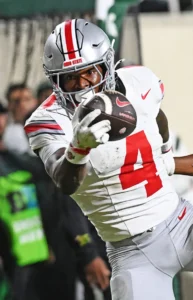
SHOCKING ESPN REPORT: Ohio State president says Ivy League schools in ‘survival mode’ after $221M Columbia deal

In a recent statement, the president of Ohio State University has asserted that Ivy League institutions are entering a phase of “survival mode” in light of Columbia University’s latest \$221 million agreement. This bold comment highlights growing concerns among prestigious private universities as they face increasing financial and competitive pressures.
The deal involving Columbia University, one of the nation’s oldest and most prestigious Ivy League schools, has sent ripples through the higher education landscape. While specifics of the agreement have not been fully disclosed, sources indicate that it involves substantial financial restructuring and strategic partnerships aimed at bolstering Columbia’s future stability and growth.
Ohio State’s president pointed out that this significant financial maneuver is emblematic of a broader trend impacting Ivy League universities. According to him, these traditionally wealthy and well-established schools are confronting challenges that threaten their long-term viability. “Many Ivy League schools are no longer just thriving,” he remarked, “they are scrambling to adapt and ensure their survival in an increasingly competitive educational environment.”
This assertion stems from several factors converging to create a tough climate for elite universities. Rising operational costs, fluctuating enrollment rates, and heightened competition from public institutions with growing reputations are all placing pressure on the financial and academic models of Ivy League schools.
The \$221 million deal at Columbia underscores how even the most renowned universities are not immune to these challenges. It reportedly involves a mix of endowment reallocation, debt management strategies, and enhanced investment in research and infrastructure. Observers suggest that Columbia’s move may be a signal to other Ivy League peers to reconsider their own financial strategies amid changing economic realities.
Public universities like Ohio State, which have traditionally operated with different funding structures, are observing these developments closely. The Ohio State president’s remarks suggest that public institutions might be better positioned to navigate this evolving landscape, given their often more diversified revenue streams and growing appeal among students seeking quality education at more affordable rates.
Experts in higher education finance emphasize that the shift in Ivy League schools’ approach reflects a broader redefinition of prestige and sustainability in academia. The historical model of relying heavily on large endowments and elite branding is being challenged by the need for more dynamic financial planning and operational flexibility.
Despite the pressures, Ivy League schools continue to attract top talent and maintain strong research output. However, the “survival mode” label indicates a recognition that they must innovate and adapt swiftly to preserve their competitive edge.
In conclusion, the Ohio State University president’s comments shed light on the complex financial and strategic challenges facing Ivy League universities today. Columbia’s \$221 million deal is a clear example of how even elite institutions are recalibrating to survive and thrive in a rapidly changing higher education ecosystem. As these schools navigate uncertain waters, their ability to balance tradition with innovation will likely determine their future success.






